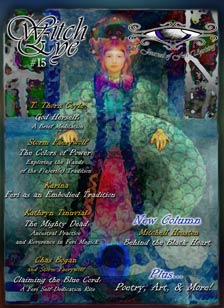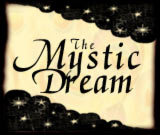|
Some Thing I Know
About Nimue
By Valerie Walker |
Originally published in Witch Eye Volume Nine
Strangely enough, Nimue, the Maiden aspect of the Triple Goddess, doesn't get written about very much by Feris, especially when contrasted with her opposite number (and occasional Twin) the Blue God. This may simply be that the majority of writers in Feri are gay men, who find the concept of an adolescent boy-god much more appealing than that of a little girl-goddess. Another reason might be that the Maiden is closer to the Crone than to the Mother: in the seasonal cycle, the Crone becomes the Maiden in the spring, and in many myths (e.g., that of Kore/Persephone) the Maiden goes to the Underworld to encounter the Crone and become transformed.

"Nimue"
by Valerie Walker
Cover for Witch Eye Volume 15 |
Both the Maiden and the Crone are spoken of among some Feris as being "androgynous", but I feel that this is a mistake. They are, repectively, pre-sexual and post-sexual; and for a religion that places so much emphasis on sex, neither is a comfortable kind of deity. I have been told that Nimue is "dangerous" to call upon, and the Faery Roads website says: "... Imagine all the power of the Cosmos in the hands of a six-year-old..."
According to what I have been told, Victor Anderson regarded Nimue as the Black Heart of Innocence incarnate. As the prepubescent girl, first emanation of the Star Goddess, Nimue is the Holy Child, the protectress and avenger of abused and mistreated children everywhere, fierce, wild, and innocent. Her priestesses wore two green snakes in their hair, and she was accorded a sacrifice of four red pigs, four white pigs, and one black pig, showing her connection to the love and death aspects of the Star Goddess.
One of Nimue's titles is "the Kymari." Corvia Blackthorn is of the opinion that this name most likely is a variant spelling of the Kumari of Nepal.
"The Kumari is the prepubescent "living Goddess" of Nepal, where she is believed to be the Great Goddess incarnate in the form of a girl child. She rules until her first menstruation, when she is dethroned and a new Kumari selected.
"The Kumari is also associated with snakes, but red ones. When a Nepalese woman dreams of a red snake, it's thought to be a sign that her daughter may be the next Kumari. The Kumari is worshipped by both Hindus and Buddhists.
"One story of the beginning of the custom of the Kumari claims that a king of Nepal had sex with a prepubescent girl. The encounter caused her death, and the king established the cult of the Kumari as penance."
Barbara Walker's Encyclopedia of Women's Myths and Secrets gives a couple of very interesting connections to the name Nimue: one to Nemesis, Retribution, and the other to Mneme, Memory. Although Walker's scholarship is noted for requiring the proverbial grain of salt, still, these two connections somehow rang an intuitive bell for me. Looking at etymology, we find that the Proto-Indo-European root nem- signifies " to divide, distribute, allot, to take." Some of the nem- words in different languages include the Gothic niman 'to take' , Old High German nemen 'to take' Old Irish nem 'gift'. Greek nemo: 'I distribute'; Avestan nemah 'loan; obligation'.
Nemesis/Nimue is the Goddess of That Which is Allotted. She gives with one hand and takes with the other. At the same time, Mneme, Memory, the shortened form of Mnemosyne, mother of the nine water-nymph Muses of Roman and Greek Mythology, is also appropriate for Nimue, because the Fetch is the seat of memory, and if there is a goddess for the Fetch it would have to be Nimue.
Nimue has been associated with Diana Nemorensis (Diana of the Woods). Lake Nemi is a lake in Italy where the temple of Diana once stood, surrounded by her sacred grove. The guardian of the sacred grove of Diana was referred to as Rex Nemorensis, the King of the Woods, the guardian of Diana's temple at Nemi. Thus Diana of the Woods is associated with both the elements of water and earth, and in fact has been spoken of as an early version of the Lady of the Lake.
And speaking of the Lady of the Lake, let us not forget the familiar temptress who was Merlin's Nemesis. In the Arthurian legend, the Lady of the Lake was the foster-mother of Sir Lancelot, presented Excalibur to King Arthur, became Merlin's scribe as well as his lover, and imprisoned him in a glass castle, cave, or tree (accounts differ). On Arthur's defeat and death in battle, she took back the sword Excalibur. She was later one of the three Queens who escorted the King to Avalon.
The Lady of the Lake is usually referred to by various spellings of the names Nimue or Vivienne. The practice of offering money or weapons to the water goddesses at wells and fountains continues today at wishing wells, and the Lady of the Lake is remembered as "Lady Luck"!
But this is taking us in the direction of thinking about Nimue as a fully-grown woman. Let us return to Nimue the child. In literature, the characters who exemplify Nimue for me are Pippi Longstocking, Neil Gaiman's Delirium of the Endless, Alice in Wonderland, and the little girl in Norah Jones' song, "Seven Years":
Spinning, laughing, dancing to her favorite song
A little girl with nothing wrong
Is all alone
Eyes wide open
Always hoping for the sun
And she'll sing her song to anyone that comes along
Fragile as a leaf in autumn
Just fallin' to the ground
Without a sound
Crooked little smile on her face
Tells a tale of grace
That's all her own
Fragile as a leaf in autumn
Just fallin' to the ground
Without a sound
Spinning, laughing, dancing to her favorite song
She's a little girl with nothing wrong
And she's all alone
A little girl with nothing wrong
And she's all alone
...That's how she comes to me, dancing. Not with a sword, but then I am no hero. I think she comes to each one as the changeable creature that she is, reflecting our true desires, our longing to be at one with our Black Heart of Innocence. Taking with one hand, giving with the other, in exotic or familiar guise, she is the essence of femininity as yet untouched, of childhood as yet unmarred.
Sources:
http://www.britannia.com/history/biographies/nimue.html
Feri roads website [website and archive no longer available]
Corvia Blackthorn gives the following weblinks for the Kumari:
http://www.visitnepal.com/nepal_information/kumari.htm
http://www.exoticindiaart.com/article/nepal/2/
Norah Jones, Come Away With Me, ©Lee Alexander, Fumblethumbs music, BMI |
|





















